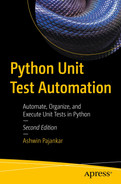Index
A, B, C
Assertions
Automated Unit Testing
D, E
Docstrings
advantage
code comments
Python
graphical representation
help() function
interpreter mode
print() function
tree diagram
doctest
command prompt
failing tests
advantages/disadvantages
execution log
novice-level testing
Pydoc
separate test file
source code
nose test
standard library
test module
verbose mode
F, G, H
Fixtures
nose
alternate names
assert_equals() method
functions
package
setup_function()/teardown_function()
stdout output
unittest
pytest
pytest.raises()
scope variables
source code
I, J, K
Integrated Development Environment (IDE)
eclipse
Geany
IDLE
PyCharm
PyDev plugin
Raspberry Pi
Selenium
Chrome browsers
exporting project
Firefox browser
logs
name creation
project base URL
project creation
recording button
renaming option
source code
stop recording
window screen
test programs
L
Linux
Logging process
crontab
definition
file operations
loguru
configuration compresses
dictionary
features
file retention
installation log
logging levels
log message format/display
tracing process
OS command line
Python
basicConfig() method
console/file handler
customization
file structure
multiple loggers
operations
rotating log file
source code
threads/multithreading
warning
writing code
M
macOS/Windows
nose
directory structure
discovery process
help and documentation
installation
nosetests command
organization
test case
verbose mode
N, O
Nose
advantages
differences
disadvantage
doctest test
fixtures
SeeFixtures
Linux computer
macOS and Windows
nose2
report generation
color output
HTML files
nosetests.html file
rednose demo
XML reports
standard library
testing tools
ok_ and eq_
@raises() decorator
@timed() decorator
unittest tests
P, Q, R
pytest
classes/packages
command-line options
failures
help
JUnit-style XML log files
profiling test
discovery
execution process
fixtures
pytest.raises()
scope variables
source code
Linux and macOS
py.test command
setup_function()/teardown_function()
simple test
test-driven development (TDD)
unittest and nose
Windows command
xUnit-style fixtures
Python
code maintaining
community
extensible
extensive standard library
features
high-level languages
history
IDE
SeeIntegrated Development Environment (IDE)
interactive mode
interpreted language
learning process
logging process
memory management
modes
object-oriented programming
open-source project
portable
powerful language
rapid prototyping tool
robustness
script mode
simple/minimalist language
software principles
Python 3
differences
features
installation
Debian/Ubuntu/derivatives
Fedora/CentOS
Linux
macOS X
Windows OS
new-style classes/exceptions
S
Selenium
browser operations
components
IDE
unittest
Webdriver
Software testing concepts
docstring
Python
source code
doctest
textbook definition
unit testing
T
Test discovery system
Test-driven development (TDD)
add() method
add() method
approach
calculator.py
feature/requirements
flow process
modification code
module
module creation
source code
test module
test_module01.py
ValueError exception
U, V
unittest module
assert methods
assertions
coding and naming conventions
command prompt
concepts
discovering and executing test
exceptions
assertRaises() method
source code
ValueError
fail() method
id() and shortDescription() methods
nose tests
PyUnit
Selenium
skipping tests
suites/runners
test methods
assertEqual() method
classes (test file/modules)
code organization
command-line options
development/testing code files
execution
fixtures
help/command-line options
inspect.stack()
packaging feature
quiet mode
setUp()/tearDown() methods
single directory
source code
subdirectory
unittest.main()
verbosity control
test_module01.py
test_module15.py
xUnit
Unit testing
automated execution and reporting
benefits
definition
W
Webdriver Selenium
Windows OS
Python installation window
security warning dialog box
setup failed message
website
X, Y, Z
xUnit-style unit testing
..................Content has been hidden....................
You can't read the all page of ebook, please click here login for view all page.
